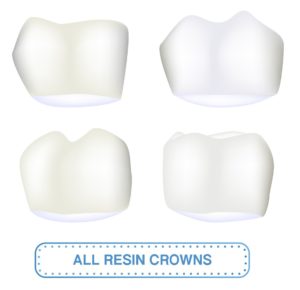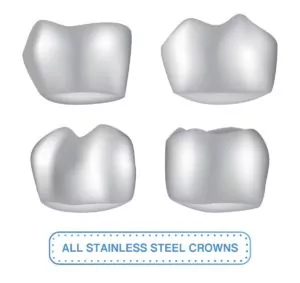If you don’t catch cavities early, the resulting decay can destroy so much of the tooth that there is not enough left to support a filling. This can also be the case with a broken tooth or with a root canal.
In these cases, a dental crown (usually either stainless steel or composite) keeps the tooth and root intact and reduces the risk of pain and infection. Dental crowns for kids are the recommended way to either keep a baby tooth in place or save a permanent tooth.
We generally recommend different types of dental crowns for different patients, depending on the situation as well as the location in the mouth where the crown will be placed.
Let’s talk more about the different scenarios that may necessitate crowns for kids teeth or crowns on baby teeth, as well as the different types of crowns available.
Types of Dental Crowns for Kids
Crowns completely cover a tooth that has very little tooth structure left or one that has had pulp treatment, has been weakened by decay, has been cracked, discolored or damaged.
In some cases, even crowns will not stay attached due to a lack of tooth structure (in that case, other treatment options, including extraction, may be considered). Usually, dental crowns for children will improve both the strength and appearance of the teeth.
Common Types of Crowns for Children’s Teeth
There are five main types of crowns for children’s teeth, with composite and stainless steel being among the most common:
- Zirconia (Porcelain/Ceramic) Crowns
- Polycarbonate Crowns (Meant for temporary repairs)
- Resin-Veneered Crowns
- Stainless Steel Crowns
- Composite Crowns
Let’s explore stainless steel, composite, and veneer
Resin & Composite (White) Pediatric Dental Crowns
A composite (white) crown may be used in some cases, however; because the crown has microscopic pores, it has a tendency to darken slightly over time, fracture, break at any time or even lead to infection.
Patients with this type of crown should not bite into anything with their front teeth; they should use their back teeth to cut food into small pieces.
Front teeth will receive resin-covered (white) crowns, the doctor will explain other options should they be necessary.
Composite white crowns are not recommended for posterior or back teeth.
Composite dental crowns are metal free and look more natural. There are a limited number of shades (colors) to choose from so a perfect match to your teeth may not be possible.
A composite dental crown isn’t as strong as natural teeth, so care needs to be taken not to bite down on hard objects that put pressure on a composite dental crown. Keep in mind that it is possible for composite dental crowns to darken slightly after time. This also can apply to zirconia (porcelain) crowns for children’s teeth.
Silver Crowns for Children’s Teeth
Stainless steel crowns are stronger, therefore they are typically used if a crown is needed for back teeth.
Stainless steel dental crowns are long-lasting and protect the tooth and root of a baby tooth until tooth loss occurs naturally. Usually a stainless steel dental crown can be placed during one appointment. The dentist shapes your child’s tooth to the necessary form and then trims a crown to fit over the tooth. The dental crown is cemented into place where it remains until the permanent tooth is ready to come in and the baby tooth falls out.
The procedure to place stainless steel dental crowns on a permanent tooth is the same; however, it is designed to remain in place for many years.
Crown Care
Patients should brush and clean their crown just like any other tooth. — Brush close to the gums and floss to prevent gum inflammation. If this should occur, you also need to bring your child in to have the crown recemented. (The glue we use to cement a crown is made up of mostly water-soluble substances and is safe, but over time, the glue may become loose).
Avoid sticky foods such as caramels, taffy, chewing gum, or even biting into an apple, which can pull the crown out or break the crown off.
Do not attempt to use super glue or to fix this issue on your own at home.
Pediatric Dental Crown FAQs
How Do Pediatric Crowns Differ From Adult Crowns?
Pediatric crowns and adult crowns are similar in that both are customized and tailored to a patient’s teeth. But pediatric crowns are applied to the teeth of children, and sometimes babies 6 months and older.
What is the Cost of White Pediatric Dental Crowns vs Stainless Steel Crowns?
People often wonder if white pediatric dental crowns cost more than stainless steel crowns or vice versa, and the answer is that metal crowns may be cheaper than porcelain crowns or crowns made of porcelain or resin fused to metal; it depends. Contact us to schedule a dental estimate/repair appointment!
How Do I Know If My Child Needs a Crown?
Teeth that require crowns are usually extremely decayed. But crowns can also be used to cover implants, to replace fillings, and to cover root canals. The only surefire way to know if your child needs a crown, versus say, an inlay or onlay, is to consult a dentist.
Pediatric Dental Crowns was last modified: February 20th, 2023 by tinyfrogsupport
Schedule an appointment or have questions?
Call Us 1 (855) GO SUPER or Text 1 (844) 765-1234









